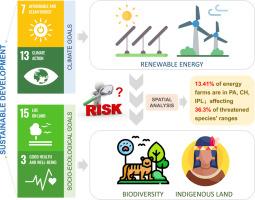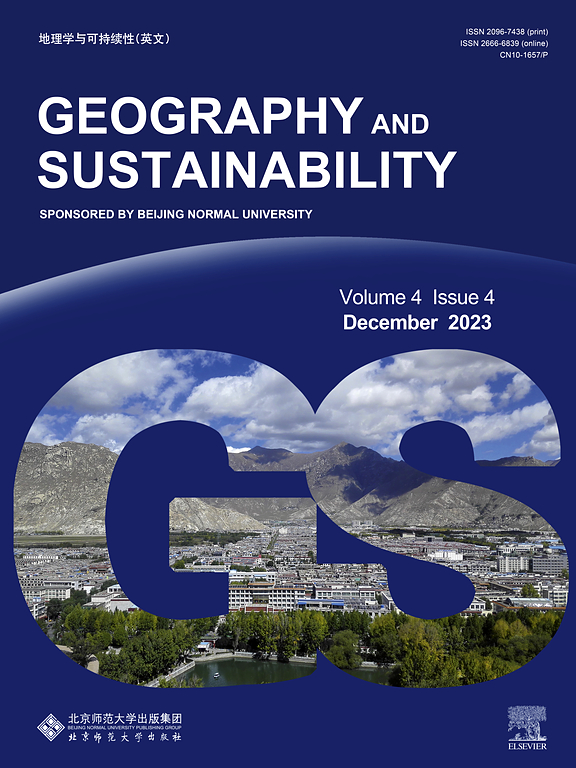A global assessment of the risks to biodiversity and Indigenous people’s lands from solar and wind farms
IF 8
1区 环境科学与生态学
Q1 GEOGRAPHY, PHYSICAL
引用次数: 0
Abstract
The share of wind and solar energy in global energy mix is rising rapidly. Despite their great potential for reducing carbon emissions, poorly planned wind and solar farms may encroach on socio-ecologically sensitive areas, threatening biodiversity and Indigenous people’s traditional land uses. However, these potential risks associated with wind and solar farm development worldwide are poorly understood. Here, we evaluate the potential biodiversity and Indigenous risks from wind and solar energy development by examining the extent to which global wind and solar farms are situated within or adjacent to socio-ecologically sensitive areas. Our analysis revealed that 13,699 wind and solar farms or 14.4 % of the farms’ total footprint area are within protected areas, critical habitats, and Indigenous people’s lands, occupying a total of 26,840 km2 of those socio-ecologically sensitive areas. Wind and solar farms overlap with the distribution ranges of 2,310 threatened amphibians, birds, mammals, and reptiles, accounting for 36.3 % of the world’s 6,362 threatened vertebrate species. The encroachment of solar and wind farms on sensitive areas mostly occurs in economically developed countries with substantial wind and solar energy facilities, while many developing countries in the tropics tend to have a higher proportion of such farms situated within sensitive areas. Compared to wind farms, solar farms pose greater risks to biodiversity and Indigenous people’s lands. These findings provide valuable insights into the socio-ecological risks of wind and solar energy development and highlight the urgent need for strategic planning to mitigate the risks.

对太阳能和风力发电场对生物多样性和土著人民土地的风险进行全球评估
风能和太阳能在全球能源结构中的份额正在迅速上升。尽管风能和太阳能农场在减少碳排放方面具有巨大潜力,但规划不当的风能和太阳能农场可能会侵占社会生态敏感地区,威胁到生物多样性和土著人民的传统土地利用。然而,这些与全球风能和太阳能发电场发展相关的潜在风险却鲜为人知。在这里,我们通过检查全球风能和太阳能发电场位于社会生态敏感区域内或邻近区域的程度,评估风能和太阳能开发的潜在生物多样性和土著风险。我们的分析显示,13,699个风能和太阳能农场(占农场总足迹面积的14.4%)位于保护区、关键栖息地和土著居民的土地上,占这些社会生态敏感区域的26,840平方公里。风能和太阳能农场与2310种濒危两栖动物、鸟类、哺乳动物和爬行动物的分布范围重叠,占世界6362种濒危脊椎动物的36.3%。太阳能和风力发电场对敏感地区的侵占大多发生在拥有大量风能和太阳能设施的经济发达国家,而热带地区的许多发展中国家往往在敏感地区拥有更高比例的太阳能和风力发电场。与风力发电场相比,太阳能发电场对生物多样性和土著居民的土地构成更大的风险。这些发现为风能和太阳能开发的社会生态风险提供了有价值的见解,并强调了迫切需要制定战略规划来减轻风险。
本文章由计算机程序翻译,如有差异,请以英文原文为准。
求助全文
约1分钟内获得全文
求助全文
来源期刊

Geography and Sustainability
Social Sciences-Geography, Planning and Development
CiteScore
16.70
自引率
3.10%
发文量
32
审稿时长
41 days
期刊介绍:
Geography and Sustainability serves as a central hub for interdisciplinary research and education aimed at promoting sustainable development from an integrated geography perspective. By bridging natural and human sciences, the journal fosters broader analysis and innovative thinking on global and regional sustainability issues.
Geography and Sustainability welcomes original, high-quality research articles, review articles, short communications, technical comments, perspective articles and editorials on the following themes:
Geographical Processes: Interactions with and between water, soil, atmosphere and the biosphere and their spatio-temporal variations;
Human-Environmental Systems: Interactions between humans and the environment, resilience of socio-ecological systems and vulnerability;
Ecosystem Services and Human Wellbeing: Ecosystem structure, processes, services and their linkages with human wellbeing;
Sustainable Development: Theory, practice and critical challenges in sustainable development.
 求助内容:
求助内容: 应助结果提醒方式:
应助结果提醒方式:


